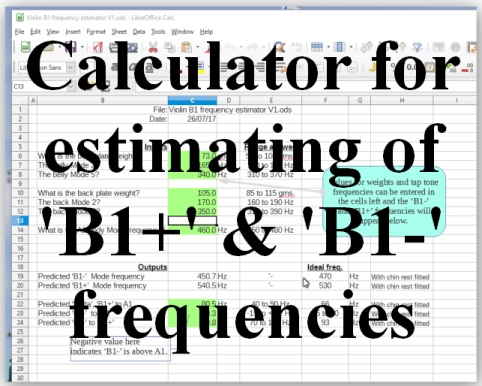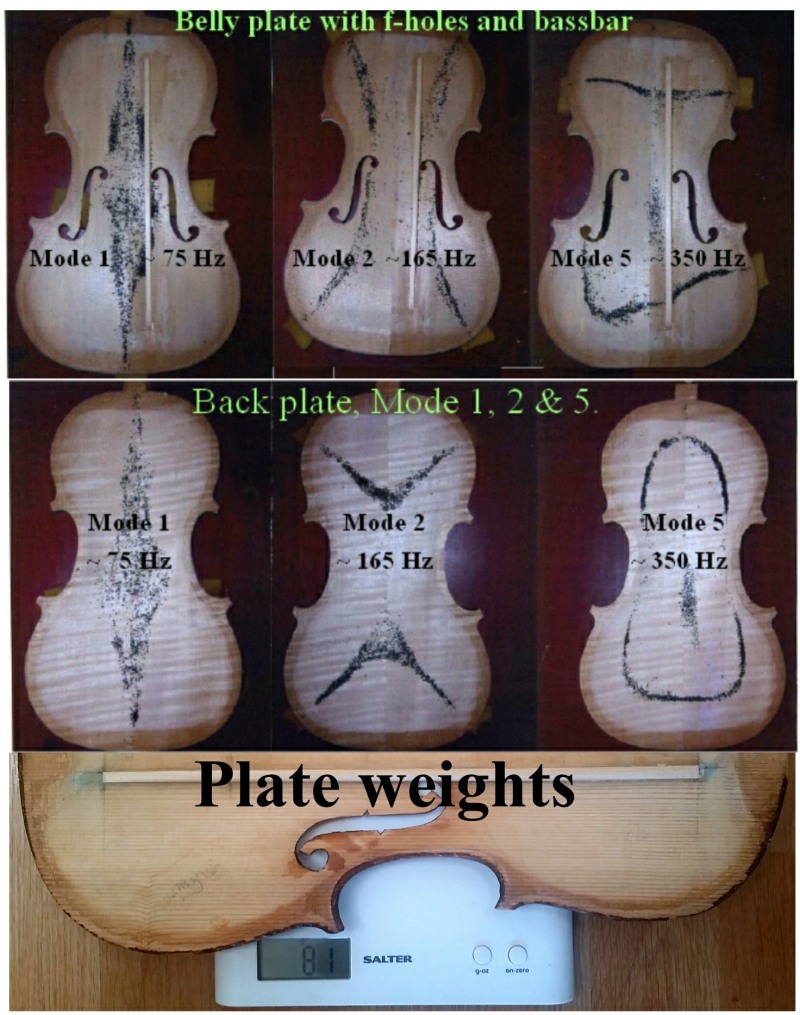|
Making or modifying a violin for good tone.
I will now show how to get an estimate of the key body frequencies of a finished violin from the weights and tap tone frequencies of the plates that go to into making it.
A ‘model’ that uses weights and tap tones to predict key body resonances1.
By concentrating on the very important B1- , B1+ and A1 violin body resonances I have derived a model to predict the B1- and B1+ violin body resonances and hence help you make what can be a fine-sounding violin.
With regard to accuracy of the model, the prediction for the frequency of B1+ has a Standard Deviation (sigma) of 10 Hz. So there is a 68% likelihood that the actual ‘B1+’ frequency will fall within +/- sigma (+/- 10 Hz) of the predicted frequency.
The model described here predicts ‘B1-’ and ‘B1+’ body mode frequencies from the characteristics of the plates. It is derived by extending the work suggested in a paper by Alonso Moral (1984) outlining these relationships. My data looks for (assumed linear) relationships between ‘B1-’, ‘B1+’ and 7 aspects of the violin plates: Modes 2 and 5 in belly and back, their respective weights and the bass-bar height.
My results show figures similar to those of Moral, but importantly I have found that the two plate's Mode 2 frequencies and their weights have a much more important effect than Mode 5!
Second Version (Version 2.0) of the model.
I first published this model in the summer of this year (2017), but when tested by well known violin makers (see Maestronet) it was found to be ‘no better than random’. Since then I have gone back to the data set, removed samples where data is questionable, and also used a method of ‘pivoting’ the results around the 2 violins (by Peter Grankulla) that I know to have excellent, indeed the best data. This has dramatically reduced the sensitivity to both the plate weights and Mode frequencies in the model which seemed to have been problematic.
The belly plate weight and the back's Mode 2 frequency dominate the resulting key body resonances.
This page has been updated with revised data 30th November 2017.
Table 1
By taking 25 violin examples where the plate Mode 2’s and Mode 5’s and the final violin B1- and B1+ mode frequencies are known I used a method of seeking multiplier values that give the lowest standard deviations for B1- and B1+ by successive iteration. This is a technique used elsewhere in Finance to minimise risk in investment portfolios.
There is a spreadsheet included below that allows you to estimate the two B1 frequencies easily.
The details of just how each factor changes the B1-, B1+ frequencies is given in this table above.
In summary:-
Estimating B1-. Accuracy: sigma ~12 Hz.
1) The data shows the back plate's Mode 2 frequency effects ‘B1-’.
A high back plate Mode 2 increases B1-, but decreases ‘B1+’: see below. The belly Mode 2 frequency affects ‘B1-’ too.
2) Other things that slightly affect the ‘B1-’ body mode frequency are :-
a) If the two plate weights are high, that is they are heavy plates, they both seem to decrease the ‘B1-’ body Mode frequency..
b) the back plate Mode 5 if it is high also increases the ‘B1-’ body Mode frequency.
>> Ideally ‘B1-’ needs to be matched or close to the A1, the lengthwise internal air resonance. It should ideally be within 0 to 16 Hz of ‘B1-’. A1 is typically 462 Hz, in the range 450 to 485 Hz.
Estimating B1+. Accuracy: sigma ~10 Hz.
>> Ideally ‘B1+’ is 60 - 90 Hz above A1.
1) The data shows the most important factors for the ‘B1+’ frequency are
a) the back plate's Mode 2 frequency, and
b) the belly plate weight. A heavy belly plate reduces ‘B1+’.
2) The next most important things are:-
a) belly plate Mode 2, and
b) the back plate Mode 5, and
c) the back plate weight.
The table, Table 2 below shows what effect increasing each item by 10 Hz or 10 grams is likely to have on the ‘B1+’ body mode frequency:-
Table 2
|
Effects on ‘B1+’ body frequency
|
Belly plate weight
|
Back Mode 2
|
Belly plate Mode 2
|
Back plate Mode 5
|
Back plate weight
|
Belly plate Mode 5
|
|
Effect on ‘B1+’ of an increase of 10 Hz or 10 grams.
|
-10 Hz
|
+9 Hz
|
+6 Hz
|
+3 Hz
|
+1 Hz
|
+2 Hz
|
|
Effect on ‘B1+’, in semi-tones
|
-0.3 semi-tone
|
+0.3 semi-tone
|
+0.2 semi-tone
|
+0.1 semi-tone
|
0 semi-tones
|
0 semi-tones
|
|
I hope it is clear from the table above that the Mode 2 of the back plate can be used to offset excess weight in the belly plate.
The challenge is to find plate weights and tap tones that not only give a ‘B1+’ body resonance around 540 Hz but to keep the ‘B1-’ frequency high enough to be near the A1 frequency. There are many combinations that can achieve this, but you might like to try the following ...
- first making the belly light, say Mode 2 - 155 Hz, Mode 5 - 330 Hz, weight 67 gms. and
- then the back plate with Mode 2 - 168 Hz, Mode 5 - 370 Hz, weight 90 gms., but such a low weight in the back does require very good maple.
A way to do this is to measure the weight of the finished belly or front plate and then make or modify the Mode 2 of the back plate to give the ‘B1+’ body resonance you want: typically a ‘B1+’ of 550 Hz. A high back Mode 2 means a thicker area between the C-bouts  of the back. of the back.
If you click on the frame right a small spreadsheet will be downloaded allowing the estimation of the two violin body Mode B1 frequencies to be automated for you. It can be opened in MS Excel,or the free OpenOffice or LibreOffice. Google Sheets will open it too, but cell locking does not work.
You just input the plate tap tones and weights and the two B1 frequencies are estimated for you.
This can be opened on your mobile too using Microsoft Office Excel. The input cells are unlocked, allowing data input. There are several Android mobile apps available too.
I will update the small spreadsheet in a few days.
The table below shows how you can trade any excess weight in the belly plate for extra back thickness between the bouts, i.e. a higher back plate Mode 2.
Select the column for the belly plate weight you have and then read off the back Mode 2 required to give the ‘B1+’ you want.
Corrections for the Belly plate Mode 2 (how far it is from the average I have given above), and Bock plate Mode 5 (again how far it is from the average I have given above) can be applied using the grid printed borttom left. The instructions are given bottom right on the
The Mode 2 frequencies of any plate can be set independently of the its Mode 5 by thinning a plate in carefully chosen areas.
This page has been updated with revised data 30th November 2017.
Table 3 (Version2.0)
Data shows surprisingly that the Mode 5 of the belly or front plate is not particularly critical: keeping plate weight to a minimum is what really matters.
It looks as if Sr. Stradivarius set the key body resonances after completing the violin, as he only finished the edge-work and inserted purfling after gluing on the belly!
The key violin body resonances are very sensitive to re-thicknessing the plates on the outside of the plates rather than the inside: so beware!
A few scrapes on the outside of one or both plates can drop the body resonances quickly, and they can't be raised again!
The ‘ideal’ body resonances.
There is data available on the key body resonances of important Italian and other violins in The Strad and other magazines. The data I found is that is most accessible is an article called  “Measurements of 10 Preference-Rated violins”, a paper presented at ACOUSTICS 2012 written by by C. Saitis, C. Fritz, B.L. Giordano, & G.P. Scavone: it can be found here. “Measurements of 10 Preference-Rated violins”, a paper presented at ACOUSTICS 2012 written by by C. Saitis, C. Fritz, B.L. Giordano, & G.P. Scavone: it can be found here.
I’ve also extracted the data from Jo. Curtin’s ‘Strad’ article of July 2009 into a chart (click on the chart right) and the [LibreOffice] spreadsheet made from it is here.
If you look at the page Resonances of the Violin Body I have extracted and enlarged the data on the best 3 violins of the 10 tested for sound quality to show the kind of body resonances you would be looking for.
A Charles Davis was in touch to tell me about another of Joseph Curtin’s Strad magazine articles on Stradivarius’ front plates, published October 2006, found at the Strad magazine website. Jo Curtin gives useful tap tone frequencies there.
------------------------------
Footnotes:
- Dr. Harris’s paper can be found here.
- ** Interestingly, F.J.Fetis’ book “A Notice of Anthony Stradivari”, on page 81, is the only one to say that the back, (actually Villaume’s real Strads and Guarnarii violins of 1850, obviously with ff’s bassbar & varnish) should be tuned a tone lower than the belly. Heron-Allen in his “Violin Making, as it was and is”, on page 132 says the back should be a tone higher than the belly. Other sources say they should match .
- *** CAS = Catgut Acoustical Society, now part of the Violin Society of America, the VSA.
- **** I had a good violin with a finished front of 101 grams! This was the third fiddle I ever worked on and though heavy, it produced an excellent tone. It was an oddity that set me on the road to tap tones .... a belly with a Mode 5 at only 316 Hz (final, with ff’s, varnish) make such a good sounding fiddle ? Odd.
|
